Related Research Articles

Hedley Verity was a professional cricketer who played for Yorkshire and England between 1930 and 1939. A slow left-arm orthodox bowler, he took 1,956 wickets in first-class cricket at an average of 14.90 and 144 wickets in 40 Tests at an average of 24.37.

Norman Walter Dransfield Yardley was an English cricketer who played for Cambridge University, Yorkshire County Cricket Club and England, as a right-handed batsman and occasional bowler. An amateur, he captained Yorkshire from 1948 to 1955 and England on fourteen occasions between 1947 and 1950, winning four Tests, losing seven and drawing three. Yardley was named Wisden Cricketer of the Year in 1948, and in his obituary in Wisden Cricketers' Almanack he was described as Yorkshire's finest amateur since Stanley Jackson.

Warwick Windridge Armstrong was an Australian cricketer who played 50 Test matches between 1902 and 1921. An all-rounder, he captained Australia in ten Test matches between 1920 and 1921, and was undefeated, winning eight Tests and drawing two. Armstrong was captain of the 1920–21 Australian team which defeated the touring English 5–0: one of only three teams to win an Ashes series in a whitewash. In a Test career interrupted by the First World War, he scored 2,863 runs at an average of 38.68, including six centuries, and took 87 wickets. He was inducted into the Australian Cricket Hall of Fame in 2000.
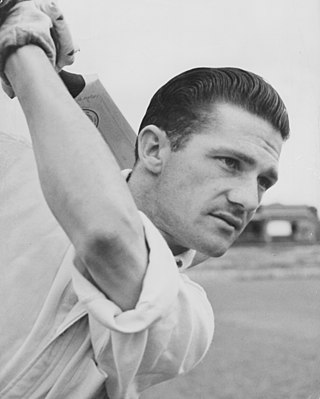
Robert Neil Harvey is an Australian former cricketer who was a member of the Australian cricket team between 1948 and 1963, playing in 79 Test matches. He was the vice-captain of the team from 1957 until his retirement. An attacking left-handed batsman, sharp fielder and occasional off-spin bowler, Harvey was the senior batsman in the Australian team for much of the 1950s and was regarded by Wisden as the finest fielder of his era. Upon his retirement, Harvey was the second-most prolific Test run-scorer and century-maker for Australia.

Robert Peel was an English professional cricketer who played first-class cricket for Yorkshire between 1883 and 1897. Primarily a left-arm spin bowler, Peel was also an effective left-handed batsman who played in the middle order. Between 1884 and 1896, he was regularly selected to represent England, playing 20 Test matches in which he took 101 wickets. Over the course of his career, he scored 12,191 runs and took 1,775 wickets in first-class cricket. A match-winning bowler, particularly when conditions favoured his style, Peel generally opened the attack, an orthodox tactic for a spinner at the time, and was highly regarded by critics.

William Arras Johnston was an Australian cricketer who played in forty Test matches from 1947 to 1955. A left arm pace bowler, as well as a left arm orthodox spinner, Johnston was best known as a spearhead of Don Bradman's undefeated 1948 touring team, well known as "The Invincibles". Johnston headed the wicket-taking lists in both Test and first-class matches on the tour, and was the last Australian to take over 100 wickets on a tour of England. In recognition of his performances, he was named by Wisden as one of its Cricketers of the Year in 1949. The publication stated that "no Australian made a greater personal contribution to the playing success of the 1948 side". Regarded by Bradman as Australia's greatest-ever left-arm bowler, Johnston was noted for his endurance in bowling pace with the new ball and spin when the ball had worn. He became the fastest bowler to reach 100 Test wickets in 1951–52, at the time averaging less than nineteen with the ball. By the end of the season, he had played 24 Tests and contributed 111 wickets. Australia won nineteen and lost only two of these Tests. In 1953, a knee injury forced him to remodel his bowling action, and he became less effective before retiring after aggravating the injury in 1955. In retirement, he worked in sales and marketing, and later ran his own businesses. He had two sons, one of whom became a cricket administrator. Johnston died at the age of 85 on 25 May 2007.

Wilfred Rhodes was an English professional cricketer who played 58 Test matches for England between 1899 and 1930. In Tests, Rhodes took 127 wickets and scored 2,325 runs, becoming the first Englishman to complete the double of 1,000 runs and 100 wickets in Test matches. He holds the world records both for the most appearances made in first-class cricket, and for the most wickets taken (4,204). He completed the double of 1,000 runs and 100 wickets in an English cricket season a record 16 times. Rhodes played for Yorkshire and England into his fifties, and in his final Test in 1930 was, at 52 years and 165 days, the oldest player who has appeared in a Test match.

Schofield Haigh was a Yorkshire and England cricketer. He played for eighteen seasons for Yorkshire County Cricket Club, for England from the 1898/99 tour to 1912, and was a Wisden Cricketer of the Year in 1901.

The Australian cricket team in England in 1948 is famous for being the only Test match side to play an entire tour of England without losing a match. This feat earned them the nickname of "The Invincibles", and they are regarded as one of the greatest cricket teams of all time. According to the Australian federal government, the team "is one of Australia's most cherished sporting legends". The team was captained by Don Bradman, who was making his fourth and final tour of England.
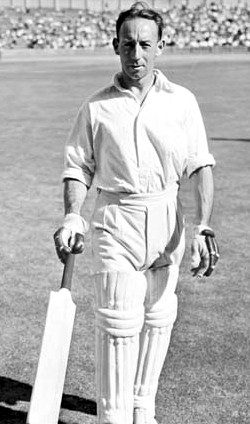
Arthur Lindsay Hassett was an Australian cricketer who played for Victoria and the Australian national team. The diminutive Hassett was an elegant middle-order batsman, described by Wisden as, "... a master of nearly every stroke ... his superb timing, nimble footwork and strong wrists enabled him to make batting look a simple matter". His sporting career at school singled him out as a precocious talent, but he took a number of seasons to secure a regular place in first-class cricket and initially struggled to make large scores. Selected for the 1938 tour of England with only one first-class century to his name, Hassett established himself with three consecutive first-class tons at the start of the campaign. Although he struggled in the Tests, he played a crucial role in Australia's win in the Fourth Test, with a composed display in the run-chase which sealed the retention of the Ashes. Upon returning to Australia, he distinguished himself in domestic cricket with a series of high scores, becoming the only player to score two centuries in a match against Bill O'Reilly—widely regarded as the best bowler in the world.
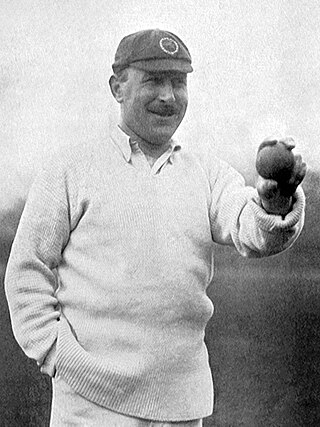
George Herbert Hirst was a professional English cricketer who played first-class cricket for Yorkshire County Cricket Club between 1891 and 1921, with a further appearance in 1929. One of the best all-rounders of his time, Hirst was a left arm medium-fast bowler and right-handed batsman. He played in 24 Test matches for England between 1897 and 1909, touring Australia twice. He completed the double of 1,000 runs and 100 wickets in an English cricket season 14 times, the second most of any cricketer after his contemporary and team-mate Wilfred Rhodes. One of the Wisden Cricketers of the Year for 1901, Hirst scored 36,356 runs and took 2,742 wickets in first-class cricket. In Tests, he made 790 runs and captured 59 wickets.

Alan Keith Davidson was an Australian cricketer of the 1950s and 1960s. He was a left-handed all rounder: a hard-hitting lower-order batsman, and an outstanding fast-medium opening bowler. Strongly built and standing six feet tall, Davidson was known for his hard hitting power, which yielded many long-hit sixes.
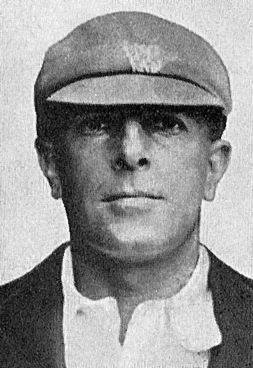
Charles George Macartney was an Australian cricketer who played in 35 Test matches between 1907 and 1926. He was known as "The Governor-General" in reference to his authoritative batting style and his flamboyant strokeplay, which drew comparisons with his close friend and role model Victor Trumper, regarded as one of the most elegant batsmen in cricketing history. Sir Donald Bradman—generally regarded as the greatest batsman in history—cited Macartney's dynamic batting as an inspiration in his cricket career.

Roy Kilner was an English professional cricketer who played nine Test matches for England between 1924 and 1926. An all-rounder, he played for Yorkshire County Cricket Club between 1911 and 1927. In all first-class matches, he scored 14,707 runs at an average of 30.01 and took 1,003 wickets at an average of 18.45. Kilner scored 1,000 runs in a season ten times and took 100 wickets in a season five times. On four occasions, he completed the double: scoring 1,000 runs and taking 100 wickets in the same season, recognised as a sign of a quality all-rounder.

Samuel John Everett Loxton was an Australian cricketer, footballer and politician. Among these three pursuits, his greatest achievements were attained on the cricket field; he played in 12 Tests for Australia from 1948 to 1951. A right-handed all-rounder, Loxton was part of Don Bradman's Invincibles, who went through the 1948 tour of England undefeated, an unprecedented achievement that has never been matched. As well as being a hard-hitting middle-order batsman, Loxton was a right-arm fast-medium swing bowler who liked to aim at the upper bodies of the opposition, and an outfielder with an accurate and powerful throw. After being dropped from the national team, Loxton represented Victoria for seven more seasons before retiring from first-class cricket. He served as an administrator after his playing days were over and spent 24 years as a Liberal Party member of the Victorian Legislative Assembly. Up until 1946, Loxton also played in the Victorian Football League (VFL) for St Kilda as a forward. In all three arenas, he was known for his energetic approach.
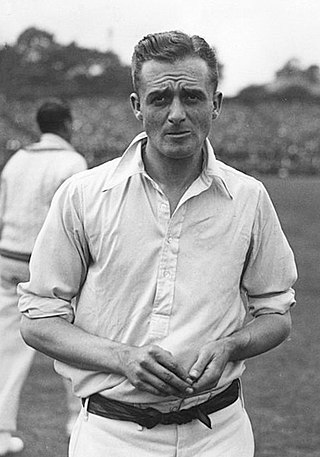
George Gibson Macaulay was a professional English cricketer who played first-class cricket for Yorkshire County Cricket Club between 1920 and 1935. He played in eight Test matches for England from 1923 to 1933, achieving the rare feat of taking a wicket with his first ball in Test cricket. One of the five Wisden Cricketers of the Year in 1924, he took 1,838 first-class wickets at an average of 17.64 including four hat-tricks.

Timothy Thomas Bresnan is an English former first-class cricketer, who last played for Warwickshire. He played as a fast-medium bowler who had ability with the bat. He was a member of the England team that won the 2010 ICC World Twenty20.

The Australian cricket team toured England during the 1902 English cricket season. The five-Test series between the two countries has been fondly remembered; in 1967 the cricket writer A. A. Thomson described the series as "a rubber more exciting than any in history except the Australia v West Indies series in 1960–61". Australia had won the previous three Test rubbers between the two countries, and now won their fourth successive series, by two matches to one with two draws. In the process they "beat the records of all their predecessors in the country" by losing only two of 39 matches during the tour, their defeats being against England in the Fifth Test and in the first of their two fixtures against Yorkshire. The remaining 37 matches gave 23 wins for Australia and 14 draws.

Jonathan Marc Bairstow is an English cricketer who plays internationally for England in all formats as a right-handed wicket-keeper-batter. In domestic cricket, he has played for Yorkshire County Cricket Club since 2009. He has also played for Sunrisers Hyderabad and Punjab Kings in the Indian Premier League (IPL).

Frank Henry Vigar was an English cricketer who played first-class cricket for Essex County Cricket Club between 1938 and 1954. A right-handed batsman, and leg break bowler, Vigar served as an all-rounder with 8,858 runs at 26.28 and 241 wickets at 37.90. From his rained-off debut in 1938, Vigar went on to play 257 matches for his county. His greatest success came in the "golden summer" of 1947, where he scored 1,735 runs and took 64 wickets. A partnership with Peter Smith of 218 for the final wicket remains an Essex record.
References
- 1 2 3 Warner, David (2011). The Yorkshire County Cricket Club: 2011 Yearbook (113th ed.). Ilkley, Yorkshire: Great Northern Books. p. 373. ISBN 978-1-905080-85-4.